Managerial Style at Marks and Spencer (M&S)
VerifiedAdded on 2023/06/18
|12
|3876
|60
AI Summary
This report analyzes the managerial style, cultural model, leadership style, motivational strategies, and effects of power, influence conflict on Marks and Spencer (M&S). The report provides recommendations for improving the performances of its employees, management, and the company as a whole.
Contribute Materials
Your contribution can guide someone’s learning journey. Share your
documents today.
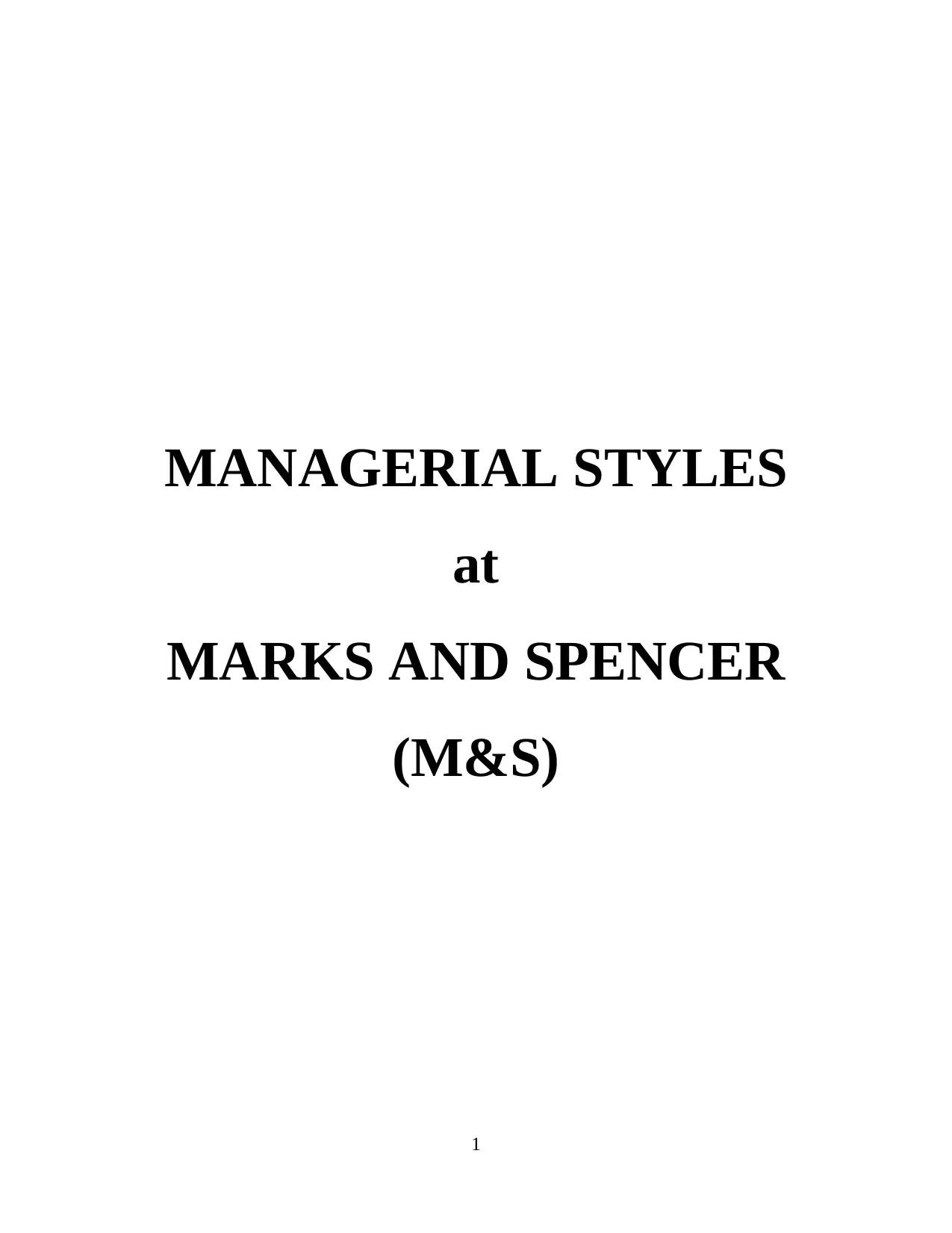
MANAGERIAL STYLES
at
MARKS AND SPENCER
(M&S)
1
at
MARKS AND SPENCER
(M&S)
1
Secure Best Marks with AI Grader
Need help grading? Try our AI Grader for instant feedback on your assignments.

Table of Contents
INTRODUCTION ..........................................................................................................................2
Marks and Spencer...........................................................................................................................2
Managerial style of CEO at M&S................................................................................................2
Cultural model of M&S...............................................................................................................3
Leadership style of CEO..............................................................................................................3
Effects of power, influence conflict on Marks and Spencer........................................................4
Motivational strategy of M&S :..................................................................................................4
Examples and literature................................................................................................................5
RECOMMENDATIONS.................................................................................................................5
CONCLUSION ...............................................................................................................................5
REFERENCES................................................................................................................................7
2
INTRODUCTION ..........................................................................................................................2
Marks and Spencer...........................................................................................................................2
Managerial style of CEO at M&S................................................................................................2
Cultural model of M&S...............................................................................................................3
Leadership style of CEO..............................................................................................................3
Effects of power, influence conflict on Marks and Spencer........................................................4
Motivational strategy of M&S :..................................................................................................4
Examples and literature................................................................................................................5
RECOMMENDATIONS.................................................................................................................5
CONCLUSION ...............................................................................................................................5
REFERENCES................................................................................................................................7
2
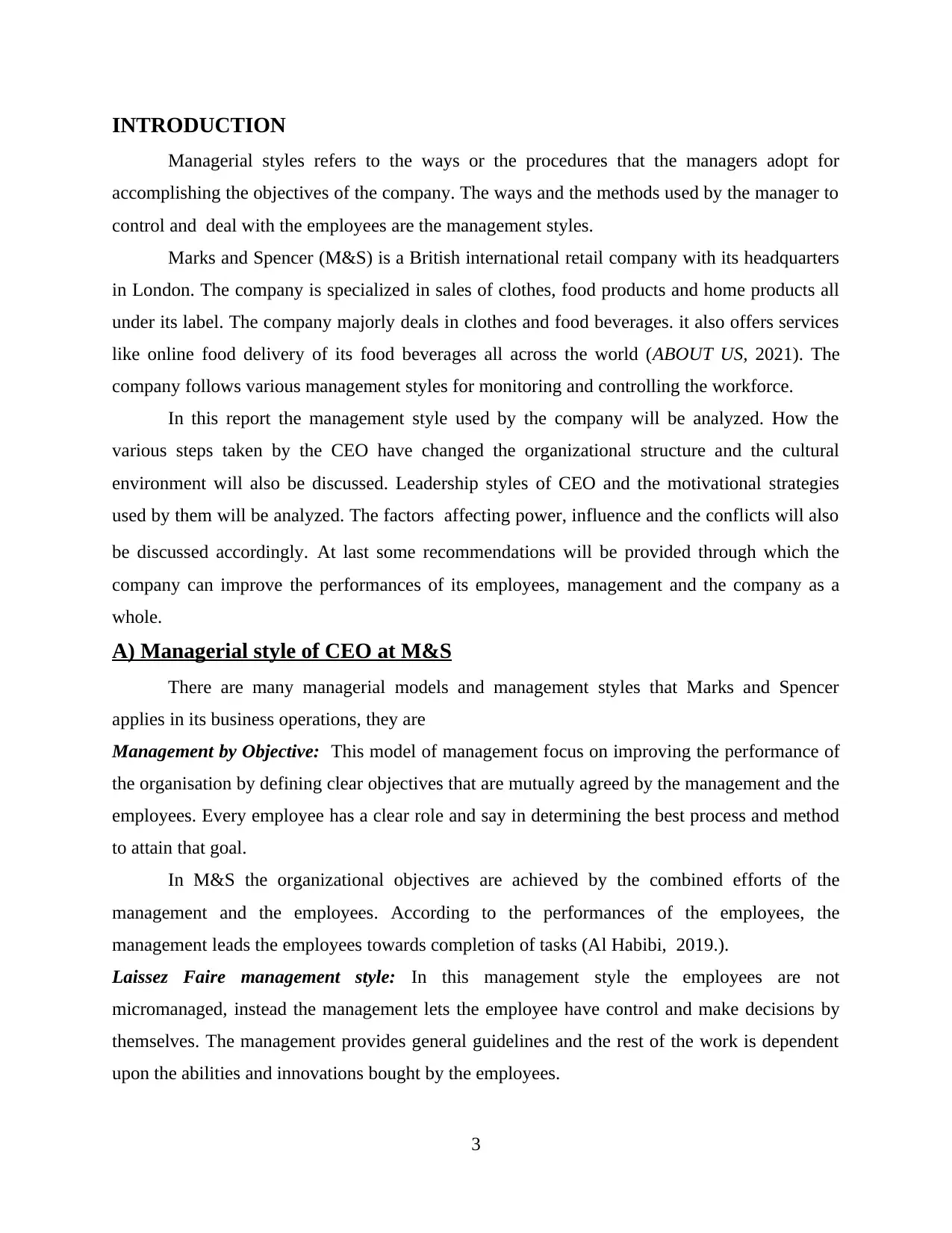
INTRODUCTION
Managerial styles refers to the ways or the procedures that the managers adopt for
accomplishing the objectives of the company. The ways and the methods used by the manager to
control and deal with the employees are the management styles.
Marks and Spencer (M&S) is a British international retail company with its headquarters
in London. The company is specialized in sales of clothes, food products and home products all
under its label. The company majorly deals in clothes and food beverages. it also offers services
like online food delivery of its food beverages all across the world (ABOUT US, 2021). The
company follows various management styles for monitoring and controlling the workforce.
In this report the management style used by the company will be analyzed. How the
various steps taken by the CEO have changed the organizational structure and the cultural
environment will also be discussed. Leadership styles of CEO and the motivational strategies
used by them will be analyzed. The factors affecting power, influence and the conflicts will also
be discussed accordingly. At last some recommendations will be provided through which the
company can improve the performances of its employees, management and the company as a
whole.
A) Managerial style of CEO at M&S
There are many managerial models and management styles that Marks and Spencer
applies in its business operations, they are
Management by Objective: This model of management focus on improving the performance of
the organisation by defining clear objectives that are mutually agreed by the management and the
employees. Every employee has a clear role and say in determining the best process and method
to attain that goal.
In M&S the organizational objectives are achieved by the combined efforts of the
management and the employees. According to the performances of the employees, the
management leads the employees towards completion of tasks (Al Habibi, 2019.).
Laissez Faire management style: In this management style the employees are not
micromanaged, instead the management lets the employee have control and make decisions by
themselves. The management provides general guidelines and the rest of the work is dependent
upon the abilities and innovations bought by the employees.
3
Managerial styles refers to the ways or the procedures that the managers adopt for
accomplishing the objectives of the company. The ways and the methods used by the manager to
control and deal with the employees are the management styles.
Marks and Spencer (M&S) is a British international retail company with its headquarters
in London. The company is specialized in sales of clothes, food products and home products all
under its label. The company majorly deals in clothes and food beverages. it also offers services
like online food delivery of its food beverages all across the world (ABOUT US, 2021). The
company follows various management styles for monitoring and controlling the workforce.
In this report the management style used by the company will be analyzed. How the
various steps taken by the CEO have changed the organizational structure and the cultural
environment will also be discussed. Leadership styles of CEO and the motivational strategies
used by them will be analyzed. The factors affecting power, influence and the conflicts will also
be discussed accordingly. At last some recommendations will be provided through which the
company can improve the performances of its employees, management and the company as a
whole.
A) Managerial style of CEO at M&S
There are many managerial models and management styles that Marks and Spencer
applies in its business operations, they are
Management by Objective: This model of management focus on improving the performance of
the organisation by defining clear objectives that are mutually agreed by the management and the
employees. Every employee has a clear role and say in determining the best process and method
to attain that goal.
In M&S the organizational objectives are achieved by the combined efforts of the
management and the employees. According to the performances of the employees, the
management leads the employees towards completion of tasks (Al Habibi, 2019.).
Laissez Faire management style: In this management style the employees are not
micromanaged, instead the management lets the employee have control and make decisions by
themselves. The management provides general guidelines and the rest of the work is dependent
upon the abilities and innovations bought by the employees.
3
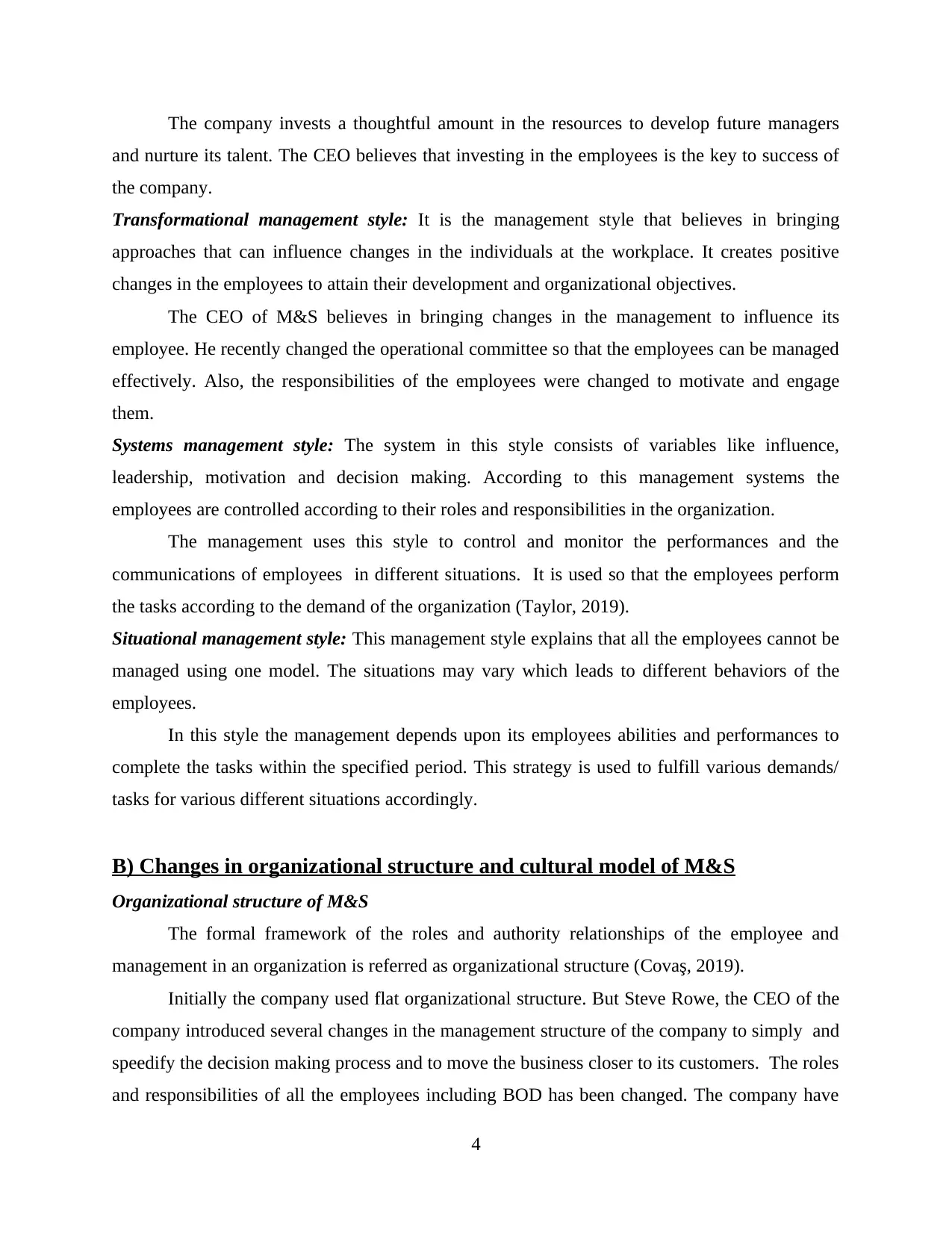
The company invests a thoughtful amount in the resources to develop future managers
and nurture its talent. The CEO believes that investing in the employees is the key to success of
the company.
Transformational management style: It is the management style that believes in bringing
approaches that can influence changes in the individuals at the workplace. It creates positive
changes in the employees to attain their development and organizational objectives.
The CEO of M&S believes in bringing changes in the management to influence its
employee. He recently changed the operational committee so that the employees can be managed
effectively. Also, the responsibilities of the employees were changed to motivate and engage
them.
Systems management style: The system in this style consists of variables like influence,
leadership, motivation and decision making. According to this management systems the
employees are controlled according to their roles and responsibilities in the organization.
The management uses this style to control and monitor the performances and the
communications of employees in different situations. It is used so that the employees perform
the tasks according to the demand of the organization (Taylor, 2019).
Situational management style: This management style explains that all the employees cannot be
managed using one model. The situations may vary which leads to different behaviors of the
employees.
In this style the management depends upon its employees abilities and performances to
complete the tasks within the specified period. This strategy is used to fulfill various demands/
tasks for various different situations accordingly.
B) Changes in organizational structure and cultural model of M&S
Organizational structure of M&S
The formal framework of the roles and authority relationships of the employee and
management in an organization is referred as organizational structure (Covaş, 2019).
Initially the company used flat organizational structure. But Steve Rowe, the CEO of the
company introduced several changes in the management structure of the company to simply and
speedify the decision making process and to move the business closer to its customers. The roles
and responsibilities of all the employees including BOD has been changed. The company have
4
and nurture its talent. The CEO believes that investing in the employees is the key to success of
the company.
Transformational management style: It is the management style that believes in bringing
approaches that can influence changes in the individuals at the workplace. It creates positive
changes in the employees to attain their development and organizational objectives.
The CEO of M&S believes in bringing changes in the management to influence its
employee. He recently changed the operational committee so that the employees can be managed
effectively. Also, the responsibilities of the employees were changed to motivate and engage
them.
Systems management style: The system in this style consists of variables like influence,
leadership, motivation and decision making. According to this management systems the
employees are controlled according to their roles and responsibilities in the organization.
The management uses this style to control and monitor the performances and the
communications of employees in different situations. It is used so that the employees perform
the tasks according to the demand of the organization (Taylor, 2019).
Situational management style: This management style explains that all the employees cannot be
managed using one model. The situations may vary which leads to different behaviors of the
employees.
In this style the management depends upon its employees abilities and performances to
complete the tasks within the specified period. This strategy is used to fulfill various demands/
tasks for various different situations accordingly.
B) Changes in organizational structure and cultural model of M&S
Organizational structure of M&S
The formal framework of the roles and authority relationships of the employee and
management in an organization is referred as organizational structure (Covaş, 2019).
Initially the company used flat organizational structure. But Steve Rowe, the CEO of the
company introduced several changes in the management structure of the company to simply and
speedify the decision making process and to move the business closer to its customers. The roles
and responsibilities of all the employees including BOD has been changed. The company have
4
Secure Best Marks with AI Grader
Need help grading? Try our AI Grader for instant feedback on your assignments.
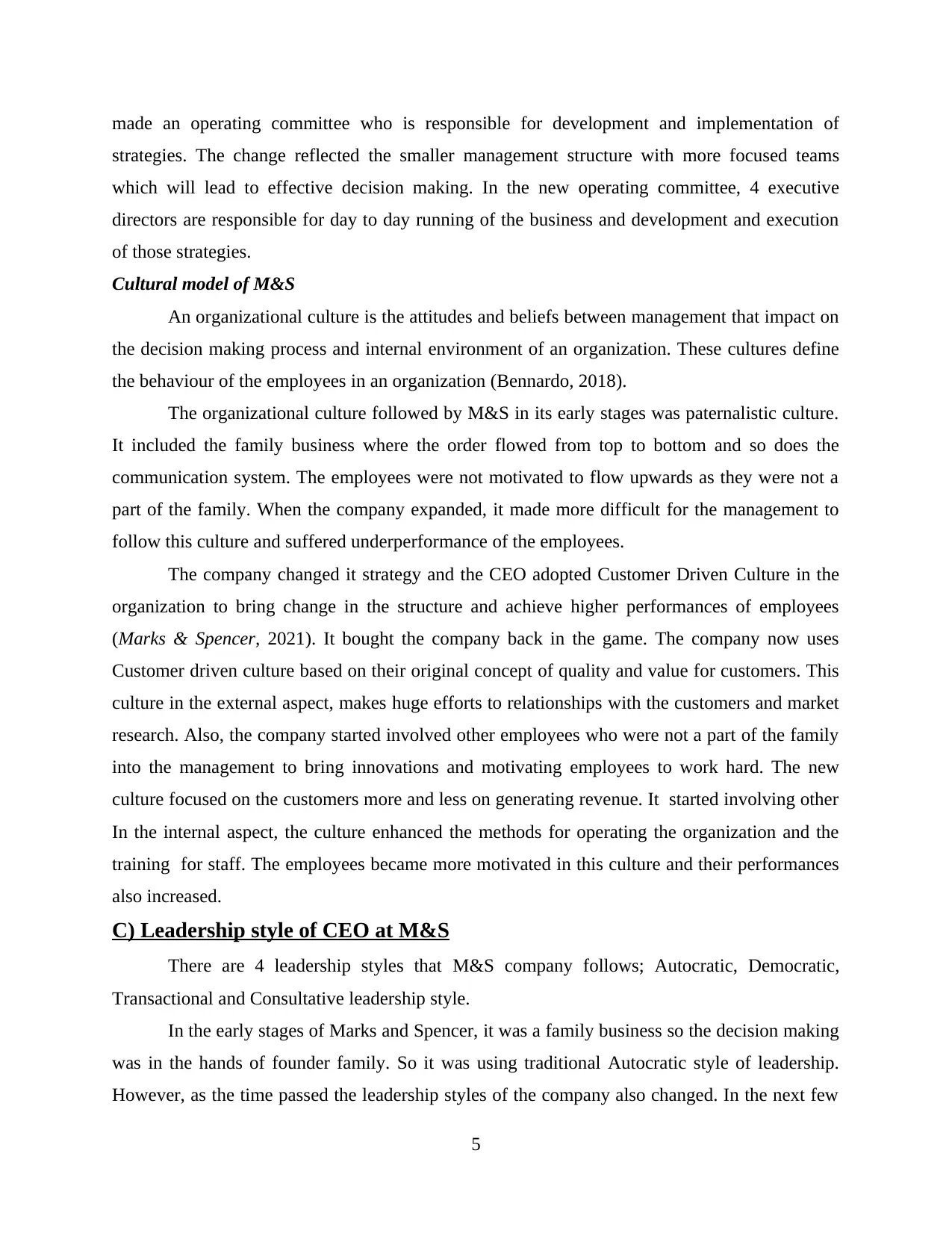
made an operating committee who is responsible for development and implementation of
strategies. The change reflected the smaller management structure with more focused teams
which will lead to effective decision making. In the new operating committee, 4 executive
directors are responsible for day to day running of the business and development and execution
of those strategies.
Cultural model of M&S
An organizational culture is the attitudes and beliefs between management that impact on
the decision making process and internal environment of an organization. These cultures define
the behaviour of the employees in an organization (Bennardo, 2018).
The organizational culture followed by M&S in its early stages was paternalistic culture.
It included the family business where the order flowed from top to bottom and so does the
communication system. The employees were not motivated to flow upwards as they were not a
part of the family. When the company expanded, it made more difficult for the management to
follow this culture and suffered underperformance of the employees.
The company changed it strategy and the CEO adopted Customer Driven Culture in the
organization to bring change in the structure and achieve higher performances of employees
(Marks & Spencer, 2021). It bought the company back in the game. The company now uses
Customer driven culture based on their original concept of quality and value for customers. This
culture in the external aspect, makes huge efforts to relationships with the customers and market
research. Also, the company started involved other employees who were not a part of the family
into the management to bring innovations and motivating employees to work hard. The new
culture focused on the customers more and less on generating revenue. It started involving other
In the internal aspect, the culture enhanced the methods for operating the organization and the
training for staff. The employees became more motivated in this culture and their performances
also increased.
C) Leadership style of CEO at M&S
There are 4 leadership styles that M&S company follows; Autocratic, Democratic,
Transactional and Consultative leadership style.
In the early stages of Marks and Spencer, it was a family business so the decision making
was in the hands of founder family. So it was using traditional Autocratic style of leadership.
However, as the time passed the leadership styles of the company also changed. In the next few
5
strategies. The change reflected the smaller management structure with more focused teams
which will lead to effective decision making. In the new operating committee, 4 executive
directors are responsible for day to day running of the business and development and execution
of those strategies.
Cultural model of M&S
An organizational culture is the attitudes and beliefs between management that impact on
the decision making process and internal environment of an organization. These cultures define
the behaviour of the employees in an organization (Bennardo, 2018).
The organizational culture followed by M&S in its early stages was paternalistic culture.
It included the family business where the order flowed from top to bottom and so does the
communication system. The employees were not motivated to flow upwards as they were not a
part of the family. When the company expanded, it made more difficult for the management to
follow this culture and suffered underperformance of the employees.
The company changed it strategy and the CEO adopted Customer Driven Culture in the
organization to bring change in the structure and achieve higher performances of employees
(Marks & Spencer, 2021). It bought the company back in the game. The company now uses
Customer driven culture based on their original concept of quality and value for customers. This
culture in the external aspect, makes huge efforts to relationships with the customers and market
research. Also, the company started involved other employees who were not a part of the family
into the management to bring innovations and motivating employees to work hard. The new
culture focused on the customers more and less on generating revenue. It started involving other
In the internal aspect, the culture enhanced the methods for operating the organization and the
training for staff. The employees became more motivated in this culture and their performances
also increased.
C) Leadership style of CEO at M&S
There are 4 leadership styles that M&S company follows; Autocratic, Democratic,
Transactional and Consultative leadership style.
In the early stages of Marks and Spencer, it was a family business so the decision making
was in the hands of founder family. So it was using traditional Autocratic style of leadership.
However, as the time passed the leadership styles of the company also changed. In the next few
5

years the company adopted the consultative leadership style, but in some of its units it used
democratic and autocratic styles too.
Transactional leadership style: The CEO of M&S is currently using Transactional leadership
style. The CEO of the company is committed to achieve the objectives of the company by
ensuring high performance by the employees at each level to bring organizational effectiveness.
The leadership style adopted by the CEO focuses on achieving the organizational goals hence
demand performances from the employees (Al Khajeh, 2018). The monetary incentives are
offered to the employees to enhance their performance and enhancing organizational
effectiveness. The employees are given short term goals to focus on, and they tend to be
inflexible. Every employee is given specific process and tasks and is motivated through
company's rewarding system. The management provides necessary resources and link their goals
to rewards for higher performance. The employees who fail to achieve their specific tasks are
guided and supervised. Necessary actions are taken by management to prevent the possible
mistakes.
The transactional leader intervene only when the goals are not attained or the
performances does not meet expectations. Sometimes they give punishments as a response to non
acceptable performances. The leadership chosen by the CEO brings out changes very smoothly
without effecting the performance of the employees and at the same times motivates them to
work hard. Their work is enhance, and they feel like their opinions matter and are valued too
(Gandolfi and Stone, 2018). It bought a major change in the organization and enhanced the
overall efficiency and effectiveness of the organization.
However, it is arguable that the company uses a single leadership style at all the levels.
The company uses other leadership styles at different departments such as the democratic
leadership style is used in the R&D department of the company. Here the employee's opinions
are heard and considered. In the production department company uses Autocratic leadership style
which means the decisions regarding production are taken by the top management without
considering opinions of the employees.
D) Effects of power, influence conflict on Marks and Spencer
The modern conflicts theory: The distributions of power influences the conflicts at a place.
Power and conflicts are interrelated and when the conflicts arise due to influence of power the
modern theory of conflicts is considered. In Mill's view, the social frameworks are created
6
democratic and autocratic styles too.
Transactional leadership style: The CEO of M&S is currently using Transactional leadership
style. The CEO of the company is committed to achieve the objectives of the company by
ensuring high performance by the employees at each level to bring organizational effectiveness.
The leadership style adopted by the CEO focuses on achieving the organizational goals hence
demand performances from the employees (Al Khajeh, 2018). The monetary incentives are
offered to the employees to enhance their performance and enhancing organizational
effectiveness. The employees are given short term goals to focus on, and they tend to be
inflexible. Every employee is given specific process and tasks and is motivated through
company's rewarding system. The management provides necessary resources and link their goals
to rewards for higher performance. The employees who fail to achieve their specific tasks are
guided and supervised. Necessary actions are taken by management to prevent the possible
mistakes.
The transactional leader intervene only when the goals are not attained or the
performances does not meet expectations. Sometimes they give punishments as a response to non
acceptable performances. The leadership chosen by the CEO brings out changes very smoothly
without effecting the performance of the employees and at the same times motivates them to
work hard. Their work is enhance, and they feel like their opinions matter and are valued too
(Gandolfi and Stone, 2018). It bought a major change in the organization and enhanced the
overall efficiency and effectiveness of the organization.
However, it is arguable that the company uses a single leadership style at all the levels.
The company uses other leadership styles at different departments such as the democratic
leadership style is used in the R&D department of the company. Here the employee's opinions
are heard and considered. In the production department company uses Autocratic leadership style
which means the decisions regarding production are taken by the top management without
considering opinions of the employees.
D) Effects of power, influence conflict on Marks and Spencer
The modern conflicts theory: The distributions of power influences the conflicts at a place.
Power and conflicts are interrelated and when the conflicts arise due to influence of power the
modern theory of conflicts is considered. In Mill's view, the social frameworks are created
6
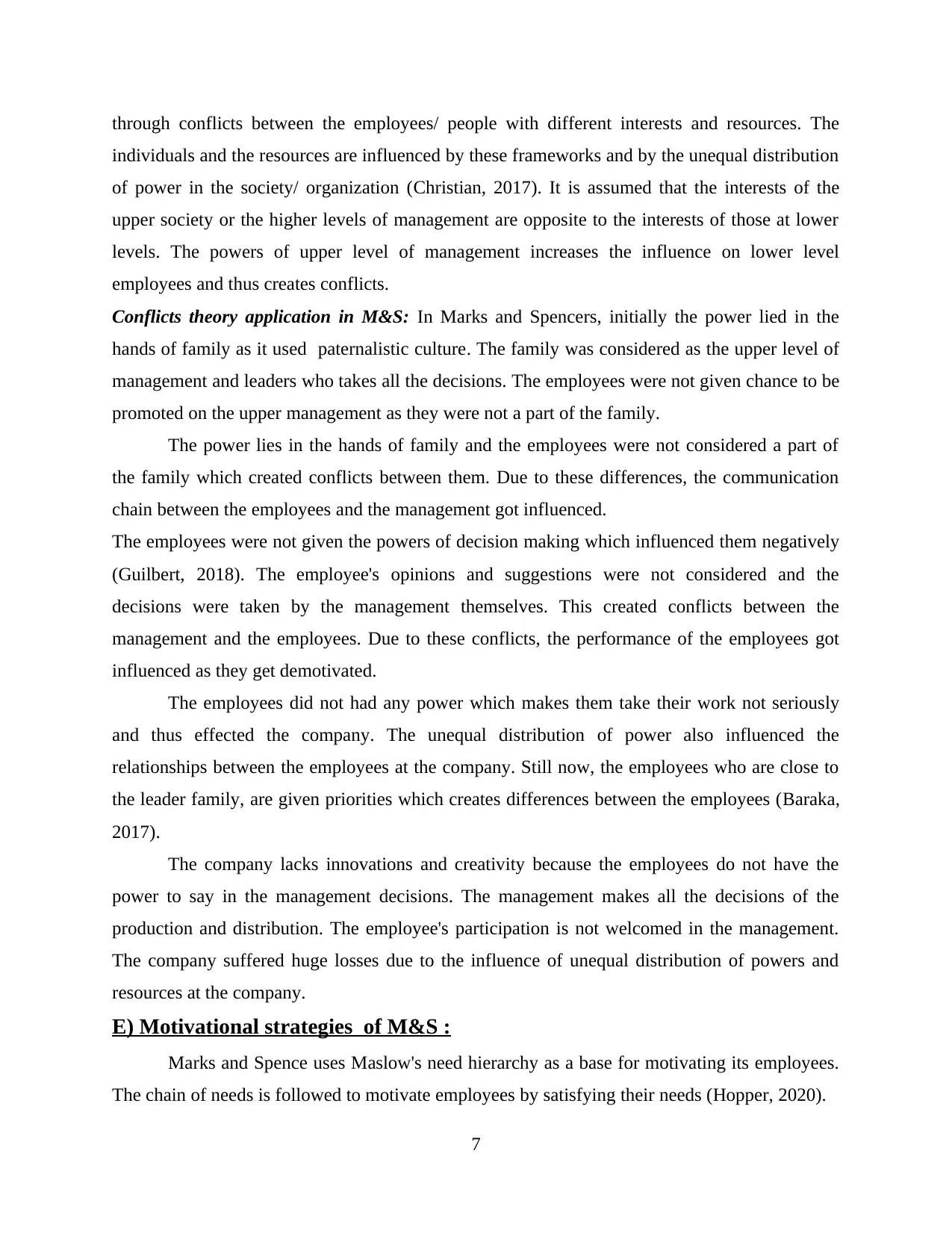
through conflicts between the employees/ people with different interests and resources. The
individuals and the resources are influenced by these frameworks and by the unequal distribution
of power in the society/ organization (Christian, 2017). It is assumed that the interests of the
upper society or the higher levels of management are opposite to the interests of those at lower
levels. The powers of upper level of management increases the influence on lower level
employees and thus creates conflicts.
Conflicts theory application in M&S: In Marks and Spencers, initially the power lied in the
hands of family as it used paternalistic culture. The family was considered as the upper level of
management and leaders who takes all the decisions. The employees were not given chance to be
promoted on the upper management as they were not a part of the family.
The power lies in the hands of family and the employees were not considered a part of
the family which created conflicts between them. Due to these differences, the communication
chain between the employees and the management got influenced.
The employees were not given the powers of decision making which influenced them negatively
(Guilbert, 2018). The employee's opinions and suggestions were not considered and the
decisions were taken by the management themselves. This created conflicts between the
management and the employees. Due to these conflicts, the performance of the employees got
influenced as they get demotivated.
The employees did not had any power which makes them take their work not seriously
and thus effected the company. The unequal distribution of power also influenced the
relationships between the employees at the company. Still now, the employees who are close to
the leader family, are given priorities which creates differences between the employees (Baraka,
2017).
The company lacks innovations and creativity because the employees do not have the
power to say in the management decisions. The management makes all the decisions of the
production and distribution. The employee's participation is not welcomed in the management.
The company suffered huge losses due to the influence of unequal distribution of powers and
resources at the company.
E) Motivational strategies of M&S :
Marks and Spence uses Maslow's need hierarchy as a base for motivating its employees.
The chain of needs is followed to motivate employees by satisfying their needs (Hopper, 2020).
7
individuals and the resources are influenced by these frameworks and by the unequal distribution
of power in the society/ organization (Christian, 2017). It is assumed that the interests of the
upper society or the higher levels of management are opposite to the interests of those at lower
levels. The powers of upper level of management increases the influence on lower level
employees and thus creates conflicts.
Conflicts theory application in M&S: In Marks and Spencers, initially the power lied in the
hands of family as it used paternalistic culture. The family was considered as the upper level of
management and leaders who takes all the decisions. The employees were not given chance to be
promoted on the upper management as they were not a part of the family.
The power lies in the hands of family and the employees were not considered a part of
the family which created conflicts between them. Due to these differences, the communication
chain between the employees and the management got influenced.
The employees were not given the powers of decision making which influenced them negatively
(Guilbert, 2018). The employee's opinions and suggestions were not considered and the
decisions were taken by the management themselves. This created conflicts between the
management and the employees. Due to these conflicts, the performance of the employees got
influenced as they get demotivated.
The employees did not had any power which makes them take their work not seriously
and thus effected the company. The unequal distribution of power also influenced the
relationships between the employees at the company. Still now, the employees who are close to
the leader family, are given priorities which creates differences between the employees (Baraka,
2017).
The company lacks innovations and creativity because the employees do not have the
power to say in the management decisions. The management makes all the decisions of the
production and distribution. The employee's participation is not welcomed in the management.
The company suffered huge losses due to the influence of unequal distribution of powers and
resources at the company.
E) Motivational strategies of M&S :
Marks and Spence uses Maslow's need hierarchy as a base for motivating its employees.
The chain of needs is followed to motivate employees by satisfying their needs (Hopper, 2020).
7
Paraphrase This Document
Need a fresh take? Get an instant paraphrase of this document with our AI Paraphraser
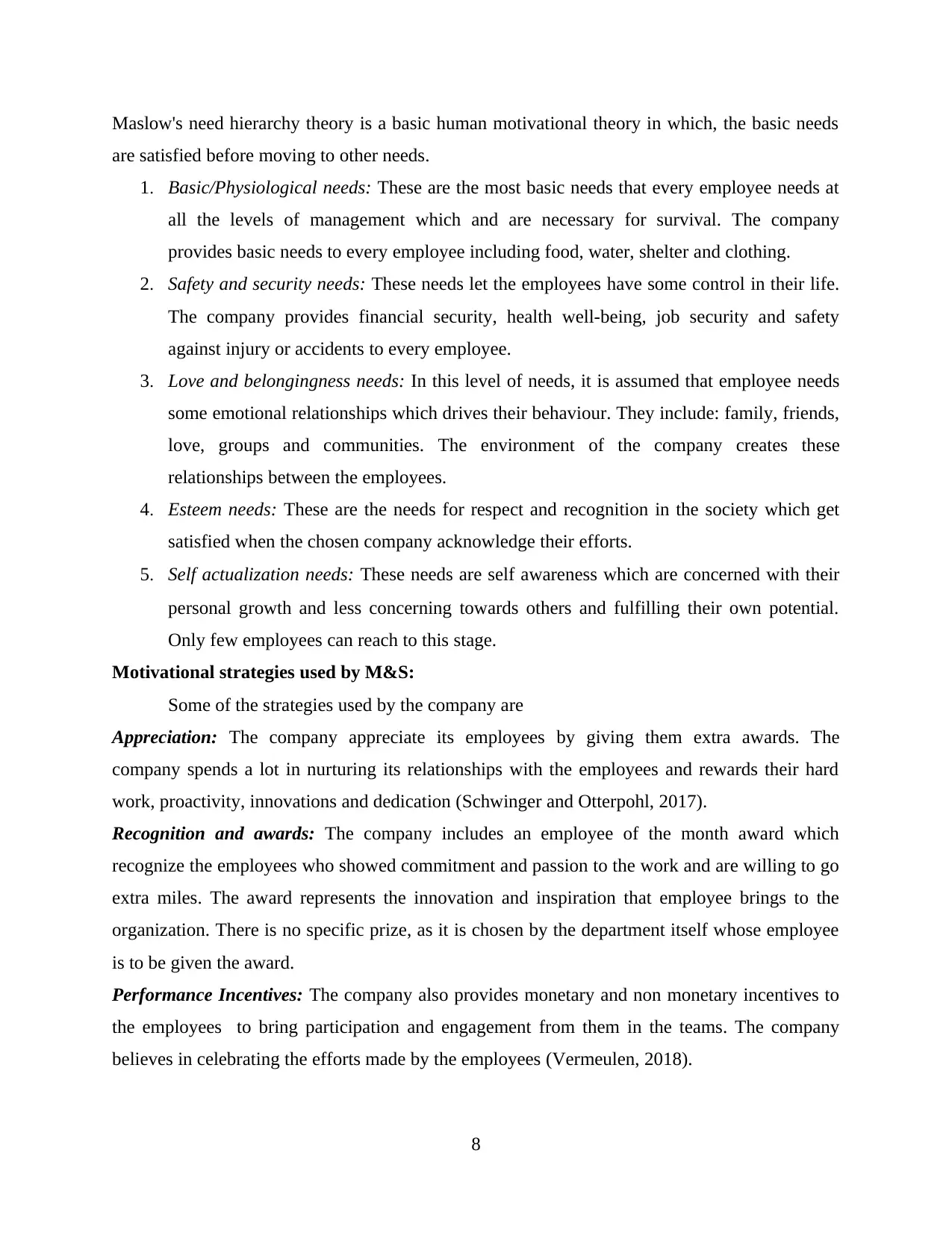
Maslow's need hierarchy theory is a basic human motivational theory in which, the basic needs
are satisfied before moving to other needs.
1. Basic/Physiological needs: These are the most basic needs that every employee needs at
all the levels of management which and are necessary for survival. The company
provides basic needs to every employee including food, water, shelter and clothing.
2. Safety and security needs: These needs let the employees have some control in their life.
The company provides financial security, health well-being, job security and safety
against injury or accidents to every employee.
3. Love and belongingness needs: In this level of needs, it is assumed that employee needs
some emotional relationships which drives their behaviour. They include: family, friends,
love, groups and communities. The environment of the company creates these
relationships between the employees.
4. Esteem needs: These are the needs for respect and recognition in the society which get
satisfied when the chosen company acknowledge their efforts.
5. Self actualization needs: These needs are self awareness which are concerned with their
personal growth and less concerning towards others and fulfilling their own potential.
Only few employees can reach to this stage.
Motivational strategies used by M&S:
Some of the strategies used by the company are
Appreciation: The company appreciate its employees by giving them extra awards. The
company spends a lot in nurturing its relationships with the employees and rewards their hard
work, proactivity, innovations and dedication (Schwinger and Otterpohl, 2017).
Recognition and awards: The company includes an employee of the month award which
recognize the employees who showed commitment and passion to the work and are willing to go
extra miles. The award represents the innovation and inspiration that employee brings to the
organization. There is no specific prize, as it is chosen by the department itself whose employee
is to be given the award.
Performance Incentives: The company also provides monetary and non monetary incentives to
the employees to bring participation and engagement from them in the teams. The company
believes in celebrating the efforts made by the employees (Vermeulen, 2018).
8
are satisfied before moving to other needs.
1. Basic/Physiological needs: These are the most basic needs that every employee needs at
all the levels of management which and are necessary for survival. The company
provides basic needs to every employee including food, water, shelter and clothing.
2. Safety and security needs: These needs let the employees have some control in their life.
The company provides financial security, health well-being, job security and safety
against injury or accidents to every employee.
3. Love and belongingness needs: In this level of needs, it is assumed that employee needs
some emotional relationships which drives their behaviour. They include: family, friends,
love, groups and communities. The environment of the company creates these
relationships between the employees.
4. Esteem needs: These are the needs for respect and recognition in the society which get
satisfied when the chosen company acknowledge their efforts.
5. Self actualization needs: These needs are self awareness which are concerned with their
personal growth and less concerning towards others and fulfilling their own potential.
Only few employees can reach to this stage.
Motivational strategies used by M&S:
Some of the strategies used by the company are
Appreciation: The company appreciate its employees by giving them extra awards. The
company spends a lot in nurturing its relationships with the employees and rewards their hard
work, proactivity, innovations and dedication (Schwinger and Otterpohl, 2017).
Recognition and awards: The company includes an employee of the month award which
recognize the employees who showed commitment and passion to the work and are willing to go
extra miles. The award represents the innovation and inspiration that employee brings to the
organization. There is no specific prize, as it is chosen by the department itself whose employee
is to be given the award.
Performance Incentives: The company also provides monetary and non monetary incentives to
the employees to bring participation and engagement from them in the teams. The company
believes in celebrating the efforts made by the employees (Vermeulen, 2018).
8
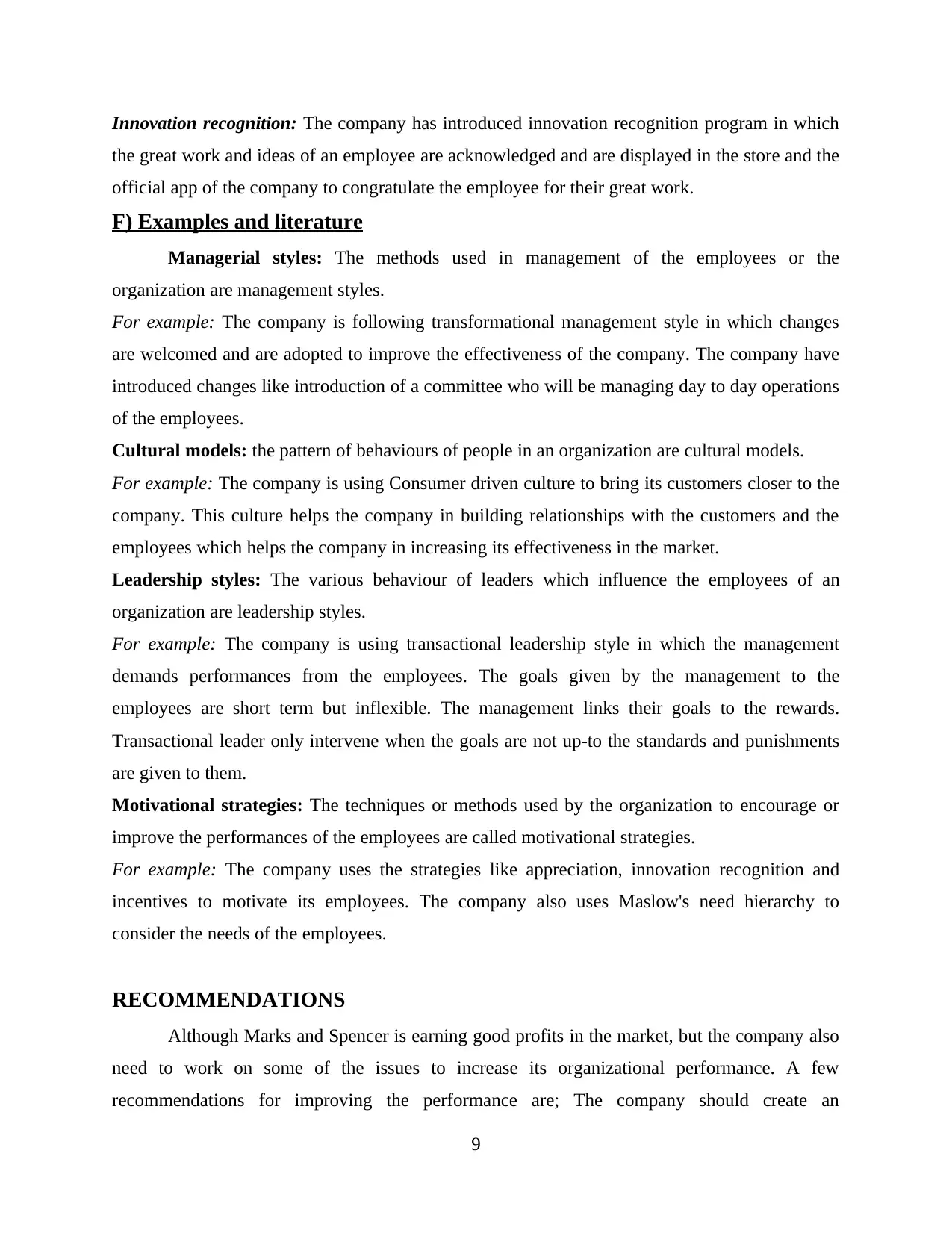
Innovation recognition: The company has introduced innovation recognition program in which
the great work and ideas of an employee are acknowledged and are displayed in the store and the
official app of the company to congratulate the employee for their great work.
F) Examples and literature
Managerial styles: The methods used in management of the employees or the
organization are management styles.
For example: The company is following transformational management style in which changes
are welcomed and are adopted to improve the effectiveness of the company. The company have
introduced changes like introduction of a committee who will be managing day to day operations
of the employees.
Cultural models: the pattern of behaviours of people in an organization are cultural models.
For example: The company is using Consumer driven culture to bring its customers closer to the
company. This culture helps the company in building relationships with the customers and the
employees which helps the company in increasing its effectiveness in the market.
Leadership styles: The various behaviour of leaders which influence the employees of an
organization are leadership styles.
For example: The company is using transactional leadership style in which the management
demands performances from the employees. The goals given by the management to the
employees are short term but inflexible. The management links their goals to the rewards.
Transactional leader only intervene when the goals are not up-to the standards and punishments
are given to them.
Motivational strategies: The techniques or methods used by the organization to encourage or
improve the performances of the employees are called motivational strategies.
For example: The company uses the strategies like appreciation, innovation recognition and
incentives to motivate its employees. The company also uses Maslow's need hierarchy to
consider the needs of the employees.
RECOMMENDATIONS
Although Marks and Spencer is earning good profits in the market, but the company also
need to work on some of the issues to increase its organizational performance. A few
recommendations for improving the performance are; The company should create an
9
the great work and ideas of an employee are acknowledged and are displayed in the store and the
official app of the company to congratulate the employee for their great work.
F) Examples and literature
Managerial styles: The methods used in management of the employees or the
organization are management styles.
For example: The company is following transformational management style in which changes
are welcomed and are adopted to improve the effectiveness of the company. The company have
introduced changes like introduction of a committee who will be managing day to day operations
of the employees.
Cultural models: the pattern of behaviours of people in an organization are cultural models.
For example: The company is using Consumer driven culture to bring its customers closer to the
company. This culture helps the company in building relationships with the customers and the
employees which helps the company in increasing its effectiveness in the market.
Leadership styles: The various behaviour of leaders which influence the employees of an
organization are leadership styles.
For example: The company is using transactional leadership style in which the management
demands performances from the employees. The goals given by the management to the
employees are short term but inflexible. The management links their goals to the rewards.
Transactional leader only intervene when the goals are not up-to the standards and punishments
are given to them.
Motivational strategies: The techniques or methods used by the organization to encourage or
improve the performances of the employees are called motivational strategies.
For example: The company uses the strategies like appreciation, innovation recognition and
incentives to motivate its employees. The company also uses Maslow's need hierarchy to
consider the needs of the employees.
RECOMMENDATIONS
Although Marks and Spencer is earning good profits in the market, but the company also
need to work on some of the issues to increase its organizational performance. A few
recommendations for improving the performance are; The company should create an
9
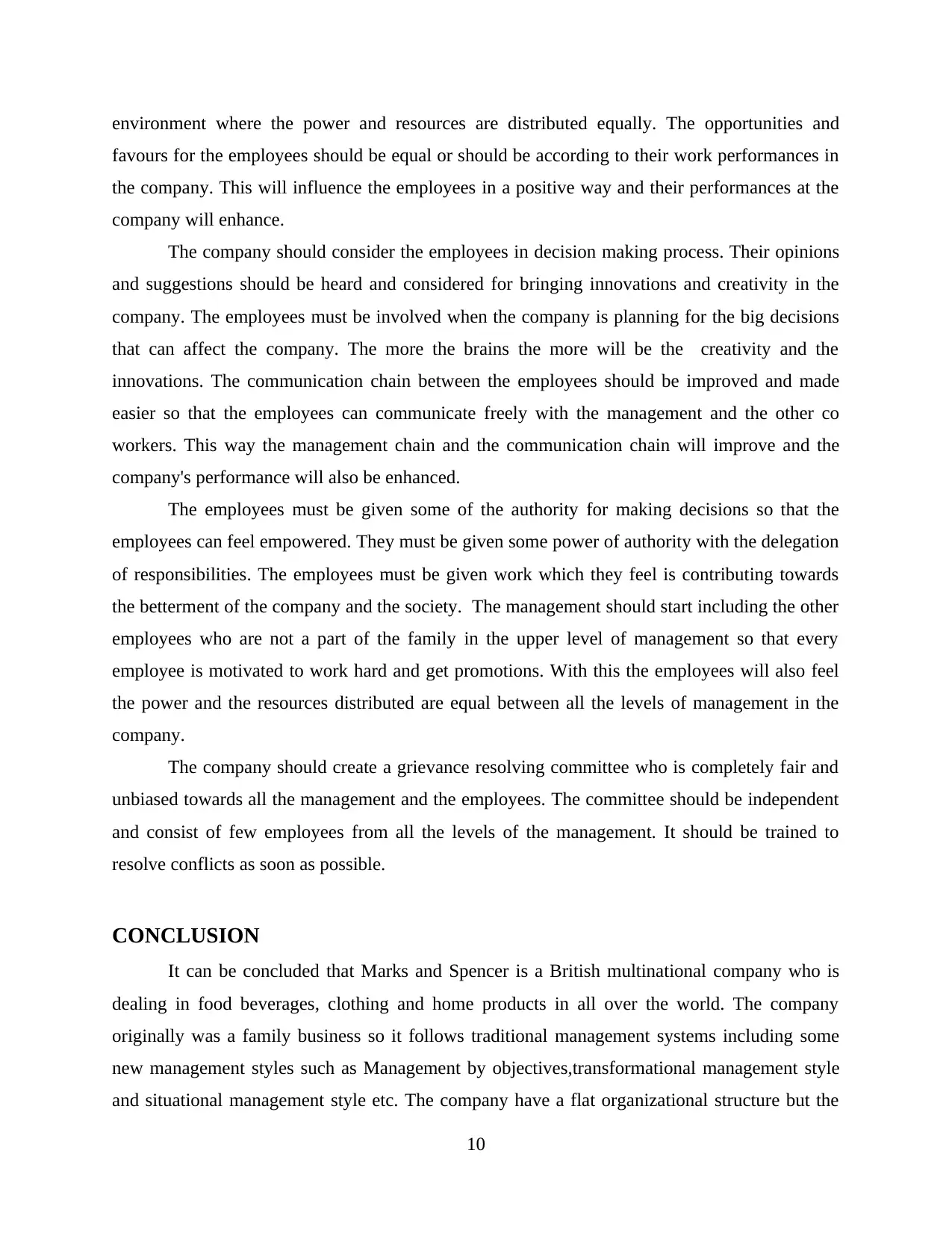
environment where the power and resources are distributed equally. The opportunities and
favours for the employees should be equal or should be according to their work performances in
the company. This will influence the employees in a positive way and their performances at the
company will enhance.
The company should consider the employees in decision making process. Their opinions
and suggestions should be heard and considered for bringing innovations and creativity in the
company. The employees must be involved when the company is planning for the big decisions
that can affect the company. The more the brains the more will be the creativity and the
innovations. The communication chain between the employees should be improved and made
easier so that the employees can communicate freely with the management and the other co
workers. This way the management chain and the communication chain will improve and the
company's performance will also be enhanced.
The employees must be given some of the authority for making decisions so that the
employees can feel empowered. They must be given some power of authority with the delegation
of responsibilities. The employees must be given work which they feel is contributing towards
the betterment of the company and the society. The management should start including the other
employees who are not a part of the family in the upper level of management so that every
employee is motivated to work hard and get promotions. With this the employees will also feel
the power and the resources distributed are equal between all the levels of management in the
company.
The company should create a grievance resolving committee who is completely fair and
unbiased towards all the management and the employees. The committee should be independent
and consist of few employees from all the levels of the management. It should be trained to
resolve conflicts as soon as possible.
CONCLUSION
It can be concluded that Marks and Spencer is a British multinational company who is
dealing in food beverages, clothing and home products in all over the world. The company
originally was a family business so it follows traditional management systems including some
new management styles such as Management by objectives,transformational management style
and situational management style etc. The company have a flat organizational structure but the
10
favours for the employees should be equal or should be according to their work performances in
the company. This will influence the employees in a positive way and their performances at the
company will enhance.
The company should consider the employees in decision making process. Their opinions
and suggestions should be heard and considered for bringing innovations and creativity in the
company. The employees must be involved when the company is planning for the big decisions
that can affect the company. The more the brains the more will be the creativity and the
innovations. The communication chain between the employees should be improved and made
easier so that the employees can communicate freely with the management and the other co
workers. This way the management chain and the communication chain will improve and the
company's performance will also be enhanced.
The employees must be given some of the authority for making decisions so that the
employees can feel empowered. They must be given some power of authority with the delegation
of responsibilities. The employees must be given work which they feel is contributing towards
the betterment of the company and the society. The management should start including the other
employees who are not a part of the family in the upper level of management so that every
employee is motivated to work hard and get promotions. With this the employees will also feel
the power and the resources distributed are equal between all the levels of management in the
company.
The company should create a grievance resolving committee who is completely fair and
unbiased towards all the management and the employees. The committee should be independent
and consist of few employees from all the levels of the management. It should be trained to
resolve conflicts as soon as possible.
CONCLUSION
It can be concluded that Marks and Spencer is a British multinational company who is
dealing in food beverages, clothing and home products in all over the world. The company
originally was a family business so it follows traditional management systems including some
new management styles such as Management by objectives,transformational management style
and situational management style etc. The company have a flat organizational structure but the
10
Secure Best Marks with AI Grader
Need help grading? Try our AI Grader for instant feedback on your assignments.

CEO Steve Rowe have introduced several changes in the culture and the management of the
company which have proved effective in enhancing the organization. The culture of the company
is still not good in some departments which needs to be changed. The company is following
customer driven culture and including more on the customers rather tan in the company as a
family business. The company is following transactional leadership style but also comprises
other leadership structures like autocratic and democratic in few of its departments too. The
company's unequal distribution of powers, management opportunities, decision making
processes and resources have given a rise to the conflicts in the company. The company needs to
be work on these issues and follow up the recommendations to bring efficiency and effectiveness
in the company.
11
company which have proved effective in enhancing the organization. The culture of the company
is still not good in some departments which needs to be changed. The company is following
customer driven culture and including more on the customers rather tan in the company as a
family business. The company is following transactional leadership style but also comprises
other leadership structures like autocratic and democratic in few of its departments too. The
company's unequal distribution of powers, management opportunities, decision making
processes and resources have given a rise to the conflicts in the company. The company needs to
be work on these issues and follow up the recommendations to bring efficiency and effectiveness
in the company.
11
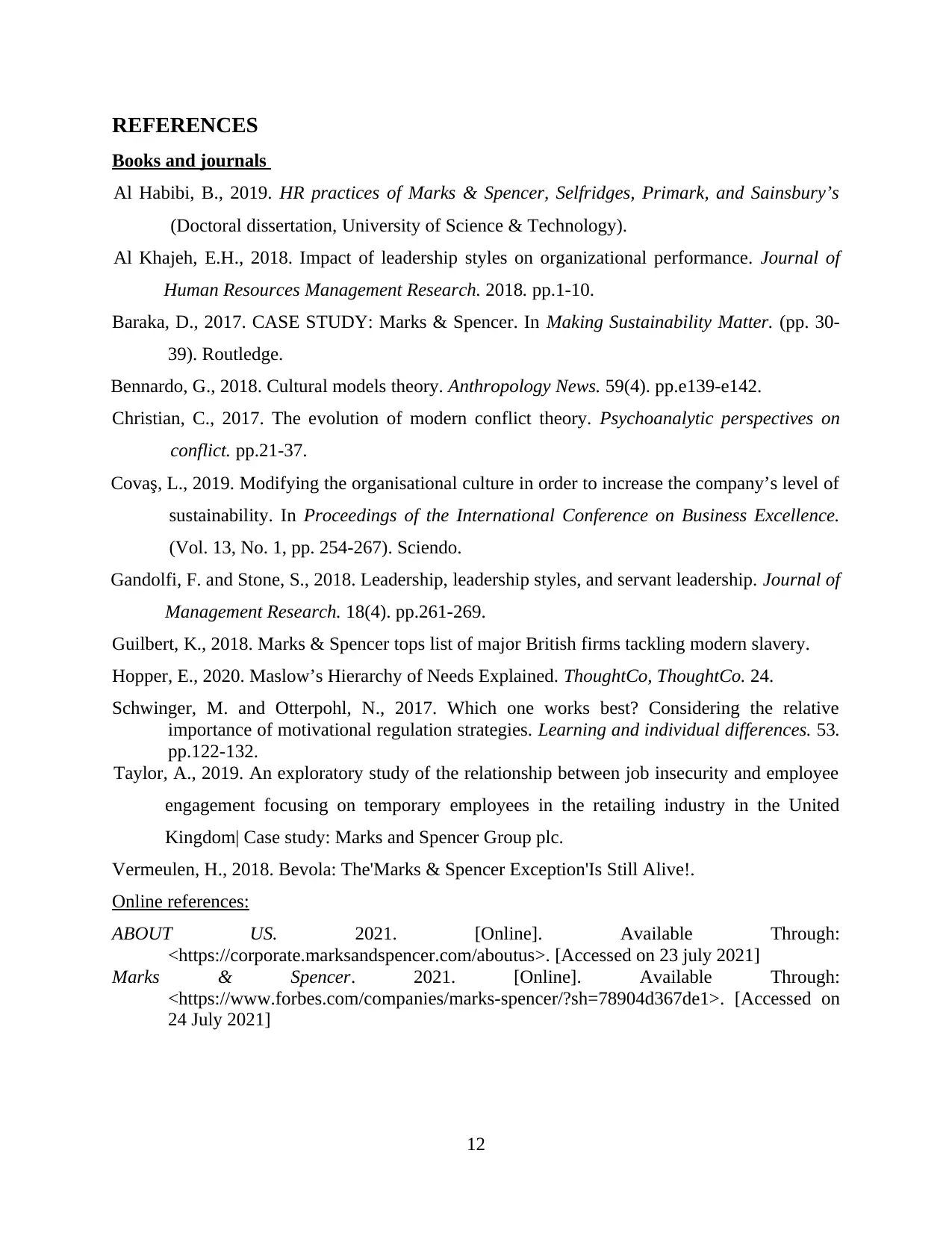
REFERENCES
Books and journals
Al Habibi, B., 2019. HR practices of Marks & Spencer, Selfridges, Primark, and Sainsbury’s
(Doctoral dissertation, University of Science & Technology).
Al Khajeh, E.H., 2018. Impact of leadership styles on organizational performance. Journal of
Human Resources Management Research. 2018. pp.1-10.
Baraka, D., 2017. CASE STUDY: Marks & Spencer. In Making Sustainability Matter. (pp. 30-
39). Routledge.
Bennardo, G., 2018. Cultural models theory. Anthropology News. 59(4). pp.e139-e142.
Christian, C., 2017. The evolution of modern conflict theory. Psychoanalytic perspectives on
conflict. pp.21-37.
Covaş, L., 2019. Modifying the organisational culture in order to increase the company’s level of
sustainability. In Proceedings of the International Conference on Business Excellence.
(Vol. 13, No. 1, pp. 254-267). Sciendo.
Gandolfi, F. and Stone, S., 2018. Leadership, leadership styles, and servant leadership. Journal of
Management Research. 18(4). pp.261-269.
Guilbert, K., 2018. Marks & Spencer tops list of major British firms tackling modern slavery.
Hopper, E., 2020. Maslow’s Hierarchy of Needs Explained. ThoughtCo, ThoughtCo. 24.
Schwinger, M. and Otterpohl, N., 2017. Which one works best? Considering the relative
importance of motivational regulation strategies. Learning and individual differences. 53.
pp.122-132.
Taylor, A., 2019. An exploratory study of the relationship between job insecurity and employee
engagement focusing on temporary employees in the retailing industry in the United
Kingdom| Case study: Marks and Spencer Group plc.
Vermeulen, H., 2018. Bevola: The'Marks & Spencer Exception'Is Still Alive!.
Online references:
ABOUT US. 2021. [Online]. Available Through:
<https://corporate.marksandspencer.com/aboutus>. [Accessed on 23 july 2021]
Marks & Spencer. 2021. [Online]. Available Through:
<https://www.forbes.com/companies/marks-spencer/?sh=78904d367de1>. [Accessed on
24 July 2021]
12
Books and journals
Al Habibi, B., 2019. HR practices of Marks & Spencer, Selfridges, Primark, and Sainsbury’s
(Doctoral dissertation, University of Science & Technology).
Al Khajeh, E.H., 2018. Impact of leadership styles on organizational performance. Journal of
Human Resources Management Research. 2018. pp.1-10.
Baraka, D., 2017. CASE STUDY: Marks & Spencer. In Making Sustainability Matter. (pp. 30-
39). Routledge.
Bennardo, G., 2018. Cultural models theory. Anthropology News. 59(4). pp.e139-e142.
Christian, C., 2017. The evolution of modern conflict theory. Psychoanalytic perspectives on
conflict. pp.21-37.
Covaş, L., 2019. Modifying the organisational culture in order to increase the company’s level of
sustainability. In Proceedings of the International Conference on Business Excellence.
(Vol. 13, No. 1, pp. 254-267). Sciendo.
Gandolfi, F. and Stone, S., 2018. Leadership, leadership styles, and servant leadership. Journal of
Management Research. 18(4). pp.261-269.
Guilbert, K., 2018. Marks & Spencer tops list of major British firms tackling modern slavery.
Hopper, E., 2020. Maslow’s Hierarchy of Needs Explained. ThoughtCo, ThoughtCo. 24.
Schwinger, M. and Otterpohl, N., 2017. Which one works best? Considering the relative
importance of motivational regulation strategies. Learning and individual differences. 53.
pp.122-132.
Taylor, A., 2019. An exploratory study of the relationship between job insecurity and employee
engagement focusing on temporary employees in the retailing industry in the United
Kingdom| Case study: Marks and Spencer Group plc.
Vermeulen, H., 2018. Bevola: The'Marks & Spencer Exception'Is Still Alive!.
Online references:
ABOUT US. 2021. [Online]. Available Through:
<https://corporate.marksandspencer.com/aboutus>. [Accessed on 23 july 2021]
Marks & Spencer. 2021. [Online]. Available Through:
<https://www.forbes.com/companies/marks-spencer/?sh=78904d367de1>. [Accessed on
24 July 2021]
12
1 out of 12
Related Documents
Your All-in-One AI-Powered Toolkit for Academic Success.
+13062052269
info@desklib.com
Available 24*7 on WhatsApp / Email
![[object Object]](/_next/static/media/star-bottom.7253800d.svg)
Unlock your academic potential
© 2024 | Zucol Services PVT LTD | All rights reserved.





